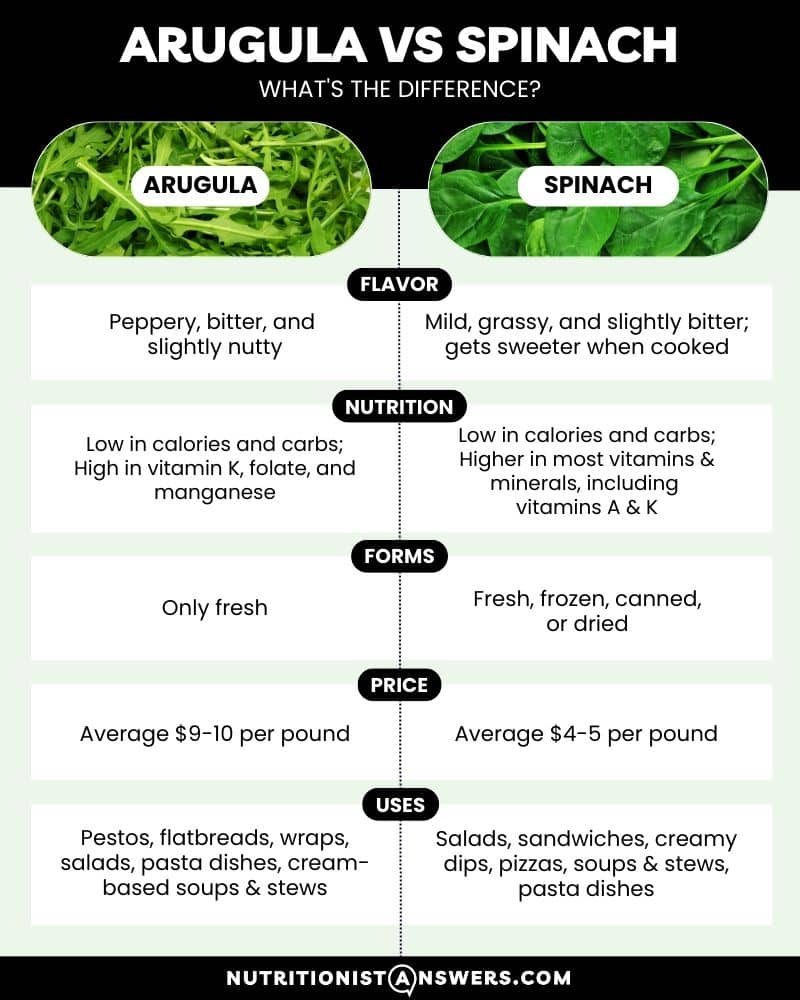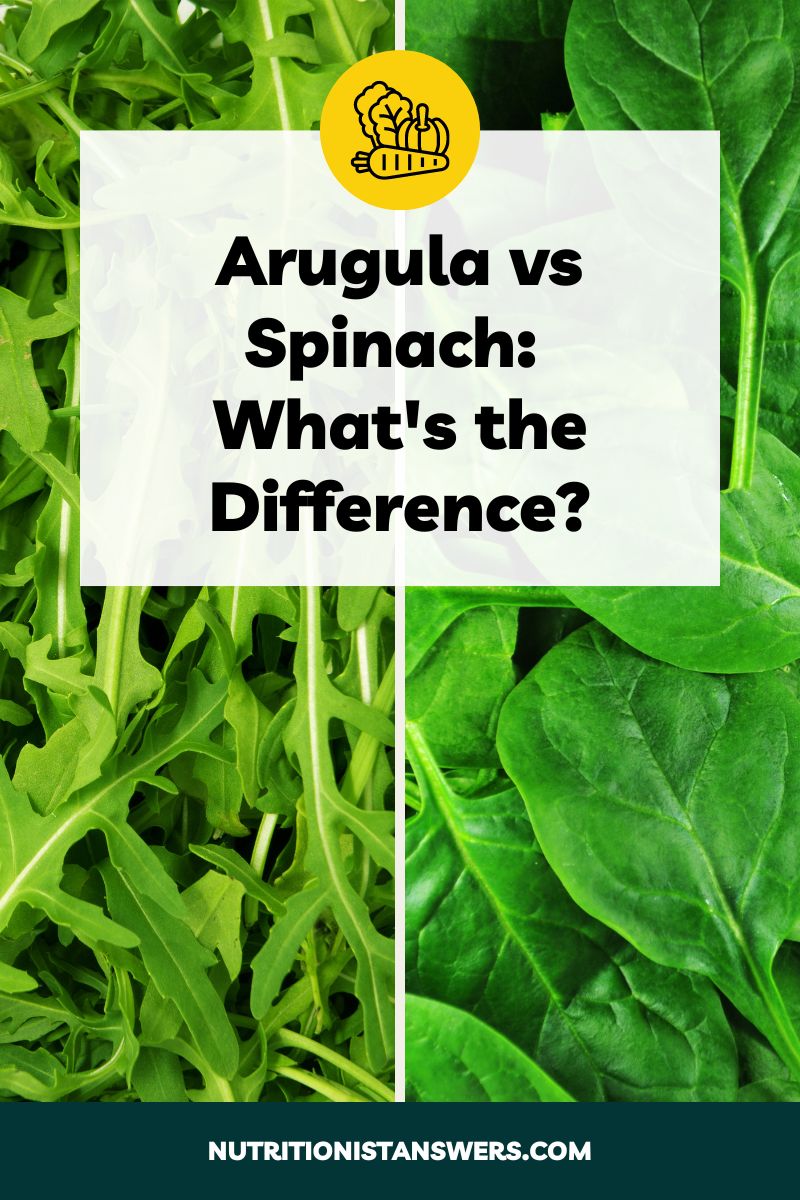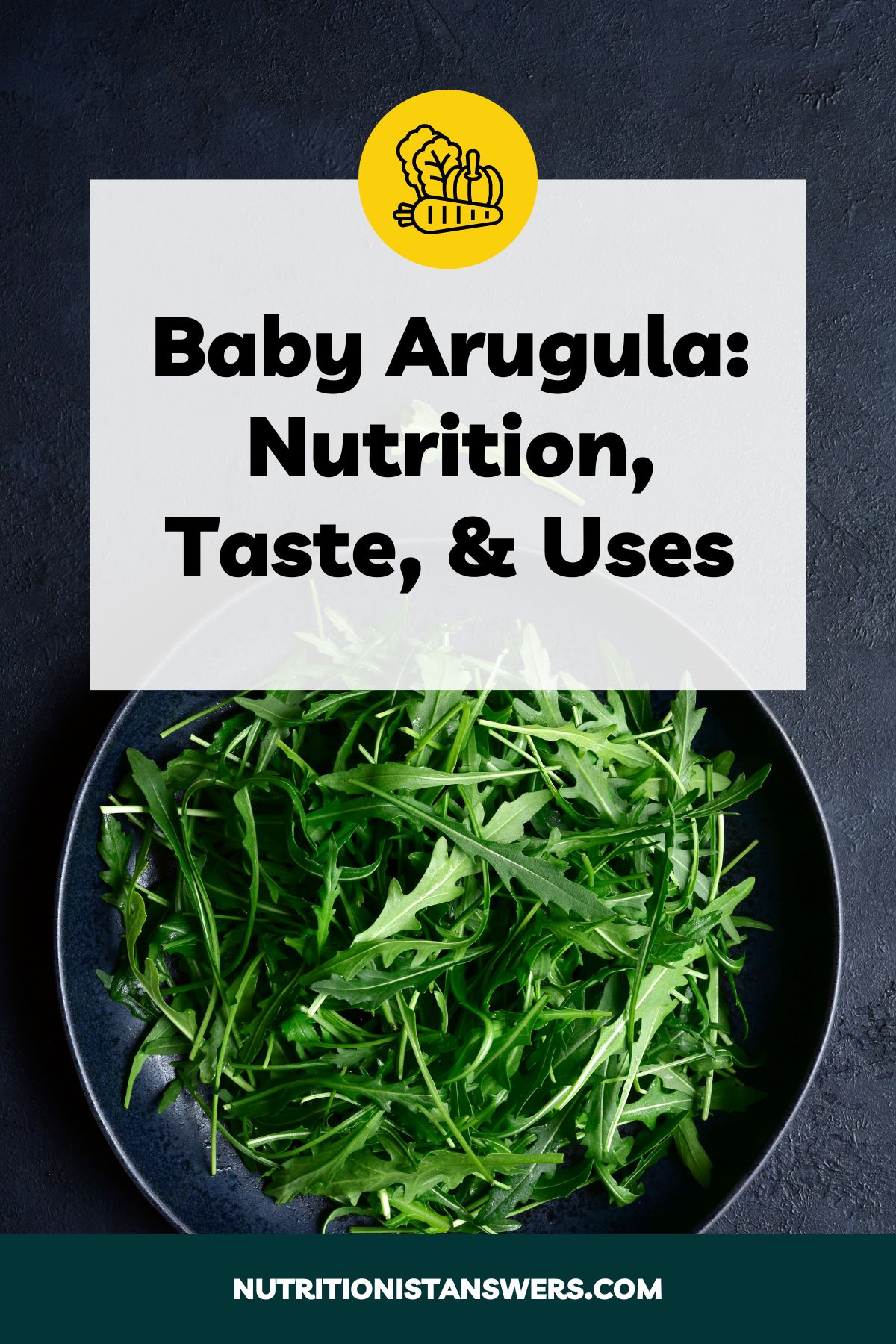In the world of leafy greens, arugula and spinach are two superstars that pack a punch in both flavor and nutritional value.
These power-packed vegetables share many similarities, but they also have some notable differences in flavor and how they are prepared.
In this article, we’ll explore the similarities and differences between arugula and spinach, in terms of nutrition, taste, available forms, prices, and uses.

Please note that this article contains affiliate links. If you click one of these links and make a purchase, we may earn a commission. As an Amazon Associate, we earn from qualifying purchases.
What is arugula?
Arugula, alternatively known as rocket, is a leafy green vegetable in the same family (Brassica) as kale, broccoli, and cabbage (1). Originally from the Mediterranean, it’s now cultivated globally.
Arugula leaves are a vibrant green color and look similar to dandelion leaves, but less jagged. They have lobes that may either be round or pointed.
Arugula has a very distinctive taste — a blend of pungent, peppery flavor with a touch of bitterness. Its leaves provide a subtle crunch that enhances the texture of salads and side dishes.
Fresh arugula is typically available in the produce section of most grocery stores, often in plastic clamshell containers or bags. It’s also frequently found at farmers markets and health food stores.
Arugula is commonly used in salads for its peppery kick, but it also works well mixed into pasta, sprinkled on top of pizzas, tucked into sandwiches, or pureed into pesto for a unique flavor.
What is spinach?
Spinach (Spinacia oleracea) is a leafy green vegetable that originated in Iran and belongs to the goosefoot family, which also includes quinoa and sugar beets (2, 3).
Spinach leaves are oval-shaped and have a vibrant, deep green color with a smooth and slightly veiny surface. The leaves shrink significantly and become softer and darker in color when cooked.
Raw spinach has a mild, slightly bitter taste with a crisp texture. When cooked, its flavor becomes sweeter and more complex, with an earthier undertone.
You can find fresh spinach in the produce aisle of most grocery stores, either loose in bunches or packaged in clear plastic bags or clamshell containers. It is also available cooked, either frozen or canned.
Spinach is incredibly versatile. It’s often used raw in salads or smoothies, or cooked in soups, stir-fries, and pasta dishes. It’s also a popular ingredient in egg-based dishes and can be used as a topping for pizzas and sandwiches.
Arugula vs spinach
Arugula has a stronger, more peppery flavor than spinach, which is mild and grassy. When cooked, arugula’s flavor becomes milder, while spinach takes on a stronger, earthier, and sweeter taste.
Both arugula and spinach are low in calories, fat, and carbohydrates and provide a small amount of protein and fiber.
Spinach is higher in most vitamins and minerals compared to arugula. However, both greens are high in folate, magnesium, manganese, and vitamins A, C, and K.
Here’s a more detailed review of how they compare in flavor, nutrition, available forms, prices, and recommended uses:
Flavor comparison
Arugula has a distinct flavor that’s peppery, bitter, and slightly nutty, while its leaves are delicate with slender stalks, providing a subtle crunch when consumed fresh.
Fresh spinach tastes mildly grassy and slightly bitter with a tender and slightly crisp texture. As it cooks, spinach shrinks and becomes softer, sweeter, and earthier.
Arugula, with its peppery flavor, pairs well with sweet fruits, balsamic vinegar, and mild cheeses, while spinach’s milder taste allows it to complement a wide array of ingredients from cheeses and nuts to meats and vegetables.
Nutrition comparison
Here’s a side-by-side comparison of the calorie and macronutrient content of raw arugula and spinach, based on a 2-cup (50-gram) serving size (4, 5):
As you can see, arugula and spinach have almost exactly the same amount of calories, protein, fat, and carbohydrates per serving.
| Nutrient | Arugula, raw (50 grams) | Spinach, raw (50 grams) |
| Calories | 13 | 12 |
| Protein | 1.3 grams | 1.4 grams |
| Fat | 0.3 grams | 0.2 grams |
| Carbohydrates | 1.9 grams | 1.8 grams |
| Fiber | 0.8 gram | 1.1 grams |
Calories
Both arugula and spinach are low-calorie foods, providing 12-13 calories per 2-cup (50-gram) serving of raw greens.
Protein
Like most other vegetables, spinach and arugula provide a very small amount of protein, each offering less than 2 grams per 2-cup (raw) serving.
Fat
Arugula and spinach are both very low in fat — a 2-cup (raw) serving of each provides less than 0.5 grams of fat.
Carbohydrates
Both spinach and arugula are low in carbohydrates, each providing around 2 grams of carbohydrates and 1 gram of fiber per 2-cup (raw) serving.
Vitamins and minerals
Here’s an overview of the vitamin and mineral content of raw arugula and spinach, based on a 2-cup (50-gram) serving (4, 5):
| Nutrient | Arugula, raw (50 grams) | Spinach, raw (50 grams) |
| Vitamin A | 60 mcg RAE (6% DV) | 234 mcg RAE (26% DV) |
| Vitamin B1 (Thiamin) | 0.02 mg (2% DV) | 0.04 mg (3% DV) |
| Vitamin B2 (Riboflavin) | 0.04 mg (3% DV) | 0.09 mg (7% DV) |
| Vitamin B3 (Niacin) | 0.2 mg (1% DV) | 0.4 mg (3% DV) |
| Vitamin B5 (Pantothenic acid) | 0.2 mg (4% DV) | <0.1 mg (1% DV) |
| Vitamin B6 (Pyridoxine) | 0.04 mg (2% DV) | 0.1 mg (6% DV) |
| Vitamin B9 (Folate) | 49 mcg (12% DV) | 97 mcg (24% DV) |
| Vitamin B12 (Cobalamin) | 0 mcg (0% DV) | 0 mcg (0% DV) |
| Vitamin C | 8 mg (9% DV) | 14 mg (16% DV) |
| Vitamin D | 0 mcg (0% DV) | 0 mcg (0% DV) |
| Vitamin E | 0.2 mg (1% DV) | 1 mg (7% DV) |
| Vitamin K | 55 mcg (46% DV) | 242 mcg (202% DV) |
| Choline | 8 mg (1% DV) | 10 mg (2% DV) |
| Sodium | 14 mg (1% DV) | 40 mg (2% DV) |
| Potassium | 185 mg (4% DV) | 279 mg (6% DV) |
| Calcium | 80 mg (6% DV) | 50 mg (4% DV) |
| Phosphorus | 26 mg (2% DV) | 25 mg (2% DV) |
| Magnesium | 24 mg (6% DV) | 40 mg (10% DV) |
| Iron | 0.7 mg (4% DV) | 1.4 mg (8% DV) |
| Zinc | 0.2 mg (2% DV) | 0.3 mg (3% DV) |
| Copper | 0.04 mg (4% DV) | 0.07 mg (8% DV) |
| Manganese | 0.2 mg (9% DV) | 0.4 mg (17% DV) |
| Selenium | 0.2 mcg (<1% DV) | 0.5 mcg (1% DV) |
Compared to arugula, spinach is higher in most vitamins and minerals.
Arugula offers slightly more pantothenic acid and calcium than spinach, but there’s only a 2-3% difference in the DV for each of these nutrients.
Spinach is especially high in vitamins A and K, providing 26% and 202% of the DV per 2-cup (raw) serving for each, respectively.
Both arugula and spinach also provide a good amount of folate, vitamin C, magnesium, and manganese.
Special Diets
If you’re following a special diet, you may be wondering whether arugula or spinach are a better choice for you.
Dairy free diet
Both arugula and spinach are naturally dairy-free.
Gluten free diet
Spinach and arugula are naturally gluten-free and can be consumed on a gluten-free diet.
Ketogenic diet
Arugula and spinach contain about 2 grams of carbohydrates per 2-cup (raw) serving, making them excellent choices for people following a keto diet.
Low fat diet
Spinach and arugula are both very low in fat, with less than 1 gram per 2-cup (raw) serving, making them ideal options for people who need to limit their fat intake.
Keep in mind that cooking oil and salad dressings will increase the fat content of dishes made with these greens..
Low-FODMAP diet
Arugula can be consumed freely on a low-FODMAP diet. According to the Monash University FODMAP Diet app, only trace amounts of FODMAPs have been detected in arugula.
Spinach can be allowed on a low-FODMAP diet, but it depends on the type and serving size.
Baby spinach, which is harvested before fully mature, is low in FODMAPs in servings of 1.5 cups (raw). Larger servings (2.75 cups or more) contain a moderate amount of fructans.
Regular, full-grown spinach, on the other hand, is low-FODMAP in servings of 2 cups (raw) and can be eaten according to appetite.
Low sodium diet
Spinach and arugula are both naturally low in sodium. However, canned spinach includes added salt and may contain around 300 mg of sodium per serving (6).
If you’re following a low-sodium diet, which limits sodium to less than 2300 mg, you may want to choose canned goods with no added salt if you can find them (7).
Another option is to rinse canned foods before eating them — this helps to reduce the amount of sodium they contain (8).
Vegetarian diet
Both arugula and spinach are plant-based and can be eaten on a vegetarian diet.
Vegan diet
Spinach and arugula are both vegan since they are plants.
Available forms
1. Fresh (arugula and spinach)
Fresh arugula and spinach are widely available in supermarkets and health food stores, where they are typically found in the produce aisle packaged in plastic bags or clamshell containers.
You might also be able to find spinach and arugula at farmers markets, especially when they are in season in the spring or fall.
2. Frozen (spinach only)
Many grocery stores carry frozen chopped spinach, often packaged in steamable plastic bags. You’ll find it in the frozen vegetables section of the freezer aisle.
Frozen spinach can be added to green smoothies, tossed into soups and pastas, blended into dips, or used in egg-based dishes like quiches and frittatas.
We weren’t able to find any frozen arugula products. Technically, arugula can be frozen, but its delicate and tender leaves are easily damaged by the cold temperatures and often turn to mush after defrosting.
3. Canned (spinach only)
Canned spinach is available at most supermarkets and can be found in the canned goods aisle. It can be eaten on its own or added to dips, casseroles, curries, and quiches.
We aren’t aware of any brands that offer canned arugula. Because arugula is so delicate and can become mushy very quickly, canning usually isn’t recommended.
4. Dried (spinach only)
Most supermarkets don’t carry dried spinach, but you might be able to find some at health food markets or online. Augason Farms is a brand that offers dehydrated spinach flakes on Amazon.
Dried spinach is a convenient, shelf-stable option that can be blended into sauces and marinades, mixed into dips, and sprinkled over savory baked goods.
Arugula usually isn’t available dried, but you can dry your own arugula at home using an oven or food dehydrator.
Cost
Arugula is usually priced about the same or up to 2 times higher than spinach. A 5-ounce container of fresh spinach or arugula costs around $3.
However, spinach is often available in larger quantities, which reduces the price per ounce.
A 1-pound (16-ounce) container of fresh spinach costs around $4-5, while you would need to spend $9-10 for the same amount of arugula from 5-ounce containers.
You can save money by growing your own greens at home. Arugula and kale prefer cool weather, so they should be planted in the early spring for spring harvest or late summer for fall harvest.
Recommended uses
Arugula and spinach can be used in many of the same ways.
1. Salads and side dishes
Arugula and spinach are versatile greens that can be used as a base for salads or tossed into side dishes with cooked grains and legumes.
Arugula is perfect for adding a peppery kick to salads and pairs well with robust flavors like citrus fruits, goat cheese, and tangy vinaigrettes.
Spinach goes well with a wide variety of ingredients such as hearty proteins like grilled chicken or salmon, earthy veggies like mushrooms, and even fruits like strawberries or apples.
If your dish requires cooked greens, spinach may be a better choice, as arugula’s delicate leaves tend to get mushy when heated.
2. Sandwiches and wraps
Incorporating arugula or spinach into your sandwiches and wraps can add a nutritional punch and a flavorful twist.
Arugula can bring a spicy kick to sandwiches or wraps and pairs well with strong, savory elements like prosciutto, goat cheese, and balsamic vinegar.
Spinach complements a wide variety of ingredients. It pairs nicely with lean proteins such as turkey or tofu, hearty grains like quinoa, and softer, milder cheeses like mozzarella or Swiss.
3. Sauces, pestos, and dips
Spinach and arugula can both be used as the base for flavorful sauces, pestos, and dips.
Arugula is great for creating bold, spicy pestos and pairs well with garlic, lemon, and parmesan cheese. Try stirring some arugula pesto into pasta dishes or using it as a base for pizza toppings.
Spinach’s milder, slightly sweet flavor pairs well with cream, nutmeg, and soft cheeses in sauces and dips. It’s also one of the key ingredients in spinach artichoke dip, a classic appetizer.
4. Pizzas and flatbreads
Arugula and spinach can add a fresh, nutritious twist to your pizzas and flatbreads.
Arugula pairs well with rich cheeses like fresh mozzarella, cured meats like prosciutto, and sweet elements like figs or caramelized onions. It’s typically added after the pizza is cooked.
Spinach complements a wide range of pizza toppings, including tomatoes, bell peppers, feta cheese, and grilled chicken. It pairs beautifully with cream-based pizza sauces.
5. Soups and stews
Incorporating leafy greens like arugula and spinach into your soups and stews can elevate their taste and nutritional content.
Arugula can add a peppery flavor to cream-based soups and complements ingredients like white beans, potatoes, and sausage. It’s best added toward the end of cooking to preserve its flavor and texture.
Spinach pairs nicely with tomato-based soups, creamy stews, and traditional chicken soup. It can be added earlier in the cooking process than arugula, as it holds up well to longer cooking times.
6. Pasta dishes
Dark, leafy greens like spinach and arugula are a great way to elevate pasta dishes and sneak in an extra serving of veggies.
Arugula pairs well with garlic butter sauce, parmesan cheese, and lemon zest. It should be tossed with the freshly cooked pasta while it is still hot — this allows the leaves to wilt without becoming mushy.
Spinach works with just about any type of pasta dish but is often paired with cream-based sauces, mushrooms, tomatoes, and grilled chicken.
Final thoughts
Arugula is known for its pungent, peppery flavor, while spinach tastes milder and a bit grassy. Both can be cooked, but spinach holds up better to heat and takes on a stronger, sweeter flavor.
Spinach and arugula are low in calories and carbohydrates and offer a small amount of fiber. Spinach is higher in most vitamins and minerals, but both greens offer a good amount of folate and vitamin K.
Arugula is usually only available fresh, but spinach can be found in other forms, such as frozen, canned, and even dried. Spinach is typically cheaper than arugula.
Both greens can be used in many of the same ways in salads, sandwiches, pizzas, soups, pasta dishes, and dips.
Want to know more? Check out our comparison of Arugula vs Kale.
Amy Richter is a Registered Dietitian Nutritionist based in Missouri. She is an experienced nutrition writer and medical advisor for Healthline and Medical News Today. Amy is passionate about all things food-related and enjoys translating complex science into easy-to-understand articles.





